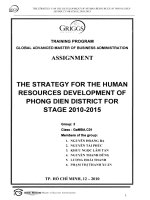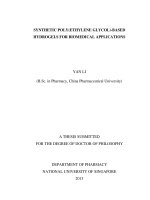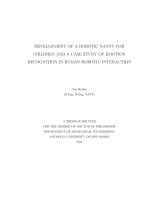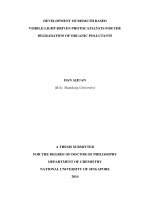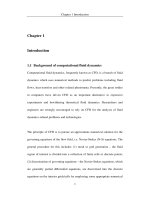Development of membrane based electrodes for electroanalytical applications 3
Bạn đang xem bản rút gọn của tài liệu. Xem và tải ngay bản đầy đủ của tài liệu tại đây (249.14 KB, 28 trang )
3
CHAPTER 3
Nanoporous membrane for the selective
transport of charged proteins
3.1 INTRODUCTION
3.1.1 Biomimetic membrane systems
In 1969, Otto H. Schmitt coined the term ‘biomimetic’. The term, itself
is derived from ‘bios’, meaning life and ‘mimesis’, meaning to imitate. Thus
biomimetic work represents the study and imitation of natural methods,
designs and processes. While some processes or designs are copied, many
ideas from nature are best adapted when they serves as inspiration for
human-made capabilities [1]. Development of biomimetic systems to mimic
cell membrane structures play important role in investigating biological
cellular processes [2, 3] and has wide applications ranging from biosensors
and therapy in medicine and pharmaceutical science to artificial
photosynthetic systems in green chemistry.
65
Several studies in the past thirty years have focused on constructing an
artificial bilayer lipid membrane that can act as cell membranes [4, 5]. The
first artificial lipid membrane system was developed by Mueller et al. in 1960s
[6], and was termed as black lipid membrane, which is the planar
phospholipids layers system, consisted of bilayer lipid membranes (BLMs)
structure located between two compartments containing aqueous solutions.
The BLMs structure functions as a barrier that prevents transportation of ions
and other charged species. Tadini et al. introduced the P-types ATPase which
is an integral membrane protein into the BLMs to study ion transport in the
ATPase [
+
7]. Other types of ATPase (Na -K
+ 2+
or Ca ) were also embedded in
the BLMs to achieve active transport of selective ions through the membranes.
The black lipid membranes are suspended freely in the solution, therefore they
are mobile and active. However, this limits the lifetime of the bilayer due to
the poor stability of the membrane. Moreover, the analytical techniques used
to study BLMs system are limited. Subsequently, more stable membranes
were developed using solid substrates to support the lipid membranes, which
are known as “supported lipid bilayers”.
A large number of supported lipid bilayer systems including
66
solid-supported lipid bilayers, polymer-cushioned lipid bilayers, hybrid
bilayers, tethered lipid bilayers, suspended lipid bilayers, and supported
vesicular layers have been studied. Naumann et al. investigated the cation
selectivity of valinomycin in tethered lipid bilayers on gold surfaces. The
impedance spectroscopy was employed to control the specific transport of
potassium ion through the tethered lipid bilayer system [
8]. Nikolelis et al.
detected ammonium ion by stabilizing the gramicidin in the metal supported
bilayer membrane [9]. They also used self-assembled lipid membrane and the
transport of DNA through the membrane to detect DNA-hybridization [10] .
Since supported lipid bilayers are tagged on the substrate surface, the mobility
and activity of the membranes are somewhat restricted; hence the stability of
the membrane improves. However, this restriction of activity presents some
disadvantages to supported lipid bilayer in cases where the mobility of protein
enzyme constituted in the membranes is necessary. Besides, the preparation of
supported lipid bilayer membranes requires specialized skills and knowledge.
Besides the studies on artificial lipid membranes, other synthetic
membrane structures with or without incorporation of chemical or biological
functional groups were used to mimic the membrane function of selective
67
transport. For example, Bernard’s group prepared the composite enzymatic
membrane (CEM) to separate the D, L forms of a racemic mixture of (D/L)
[11], and to isolate and to concentrate the L form. Martin et al. could achieve
fivefold difference between the transport rates of D- and L-amino acids
through a microporous polypyrrole/polycarbonate/polypyrrole sandwich
membrane immobilized with apoenzymes within the membrane channel [12].
Shufang et al. used gold nanotube membrane derivatized with poly(ethylene
glycol) to separate some proteins such as lysozyme, bovine serum albumin and
β
-lactoglobulin A [13]. Instead of using biological or chemical function
groups, other studies exploited the external charged potential to drive the
transport of the analytes across the synthetic membranes. Recent works by
White et al. demonstrated the use of the electrostatic and photochemical
controls for specific transport of different charged species through the
ion-exchange membrane [14, 15]. In their later work, Matin’s and Strove’s
groups also employed transmembrane potentials to produce driving forces for
both flux and electrophoresis selectivity of proteins across the gold-coated
nanotube transmembrane based on their differences on protein charges [16-18].
Yamauchi et al. investigated the diffusion of charged trypsin through the
68
polyelectrolyte PVA/PAA membrane by an externally applied electric field
[
19]. In many of previous studies, the electric field was applied far across the
membrane using inert electrodes immersed in the cell compartments on either
side of the membrane. This reduced the magnitude of applied potential
across the membrane due to ohmic resistance in the bulk solution, causing
potential drop especially when current passed was high.
The nanoporous alumina membranes, a type of ceramic membranes,
have been used to study the transport of analytes through membranes. One
advantage of alumina membrane is its controllable pore size. The pore size of
alumina membrane can be adjusted from few nm to few hundreds of nm
depending on the fabrication methods. In the early work, Bluhm et al. studied
transport behavior of monovalent and divalent solutes across mesoporous
Anopore γ-alumina membranes as a function of pore diameter, pH, ionic
strength, and nature of the salt or complexing species in solution [20]. They
proposed a correlation between cation selectivity and membrane structure,
which has become the basis for later work with alumina membranes. In
another work, Teramae et al. studied the diffusion of metal complexes and
charged organic dye molecules through the silica-surfactant nanochannels in
69
porous alumina membrane [21, 22].
In our work, the nanoporous alumina membrane was employed to study
the transports of different charged proteins through the membrane channels.
We focused on the influence of transmembrane potentials on the transport
behavior of differently charged proteins. The alumina membrane was
fabricated in same way as the electrode-membrane-electrode system used for
the collection and shielding experiments of ferrocenes, in Chapter 2. Unlike
other works [19] in which the biological analytes were transported through the
membranes by an external electrical field applied at electrodes placed some
distances away from the membranes, in our study the electric field was applied
directly at the platinum-coated layers of a micrometer-thick membrane. This
has the advantage of achieving high field strengths of about 30 kV
m
−1
suitable
for electrokinetic transport of proteins using very small transmembrane
potential of 2 V. Three common proteins with different charges were used in
this work. They were positively charged lysozyme, negatively charged bovine
serum albumin and neutral haemoglobin in buffer solutions of pH 7.
70
3.1.2 Lysozyme
Lysozyme from chicken egg was first described by Laschtschenko in
1909. Lysozyme (Lys) is widely distributed and is found in not only egg white
but also in many animal tissue and secretions, and some fungi. Alternative
names for l
ysozyme are 1,4-N-acetylmuramidase, L-7001,
N,O-diacetylmuramidase, PR1-Lysozyme, Globulin G1, Globulin G,
Lysozyme g, Mucopeptide N-acetylmuramoylhydrolase, Mucopeptide
glucohydrolase and Muramidase. Lys is a peptide chain which contains 129
amino acids and four disulfide bonds, with a molecular weight of 14.3 kDa,
and the theoretical isoelectric point of 11. Lys has wide range of applications,
such as in nucleic acid or plasmid preparation, chitin/bacterial cell walls
hydrolysis, or protein purification from inclusion bodies [23].
3.1.3 Bovine serum albumin
Bovine serum albumin (BSA) which is also known as “Fraction V” is a
large globular protein (66000 Dalton, dimension of 40×40×140 Å
3
) [24]. The
name “Fraction V” refers to the albumin in the fifth fraction of the original
Edwin Cohn purification method. By changing solvent concentrations, pH, salt
levels, and temperature, Edwin Cohn was able to pull out successive
71
"fractions" of blood plasma. Bovine serum albumin (BSA) makes up
approximately 60% of all proteins in animal serum. BSA is stable, and not
affected in many biochemical reactions. Moreover, BSA is easily purified in
large amount from bovine blood, a by-product of cattle industry; therefore, it has
wide applications. BSA is used as the standard protein in some methods to
quantify other proteins. BSA can stabilize some enzymes during digestion of
DNA and prevent the adhesion of enzymes to reaction tube and vessels. BSA
protein is composed of 583 amino acid residues with overall isoelectronic point
of 4.7 in water at 25
0
C.
3.1.4 Myoglobin
Myoglobin (Mb) is a single-chain globular protein which contains 153
amino acids. It has a molecular weight of 17800 Daltons. Isoelectric point in
water at 25
o
C of Mb from horse is 6.9. Mb is found in cardiac and red skeletal
muscles, where it functions in the storage of oxygen and facilitates oxygen
transport to the mitochondria for oxidative phosphorylation. Mb is abundant in
diving mammals such as whales and seals, helping them to hold breath longer.
72
3.2 EXPERIMENTAL
3.2.1 Reagents and materials
Bovine serum albumin (BSA), lysozyme from chicken egg white (Lys)
and myoglobin from horse heart (Mb) were purchased from Sigma-Aldrich.
All protein solutions were prepared in ultrapure water (Nanopure Ultrapure
Water System) in order to increase the Debye length of the charged protein
molecules and hence their interaction with the charges on the electrode layer
adjacent to the receiver solution. The feed concentrations of BSA, Lys and Mb
were 5 g L
−1
, 2 g L
−1
and 2 g L
−1
, and their solution pHs were 7.5, 5.5 and 7.4,
respectively. 13 mm diameter membrane with 60 μm thickness and 100 nm
nominal pore size and membrane holder were purchased from Whatman
(Maidstone, Kent, UK).
3.2.2 Preparation of platinum-coated alumina membrane
All membranes were washed and pre-treated with 35% hydrogen
peroxide (Scharlau) and subsequently sputtered with platinum (99.99% purity)
using a JEOL AutoFine Coater (JFC-1600). Sputtering conditions were
optimized to achieve sufficiently high conductivity and to maintain the porous
structure. The thickness of the sputtered platinum layer was about 50 nm. A 1
73
mm thick ring along the outer edge of the membrane was left uncoated to
avoid short circuiting when the potential was applied on the two sides of
membrane. The membrane was placed in a membrane holder made conductive
by sputter-coating micrometer thick platinum layers along selective areas to
maximize electrically conductive contacts with the membrane. The platinum
coated regions of the holder were connected to a potentiostat (eDaq EA161)
via copper wires. The working electrode was connected to the receiver side of
the membrane while the auxiliary and reference leads were attached to the
feed side of the membrane. The membrane was left in contact with the feed
solution for about 5 min before applying the electrical potential. Epoxy glue
was applied generously to insulate and keep all electrical components and
connections intact.
3.3 RESULT AND DISCUSSION
3.3.1 Fluxes of single proteins under the influence of electrical potential
Fig. 3.1 shows the schematics of the platinum-coated alumina membrane
system. All protein solutions prepared from the stock solution were stored at 4
o
C and used within three days of preparation. 5 mL protein solution was
74
introduced into the feed compartment and the feed concentrations for BSA,
Lys and Mb were 5 g L
-1
, 2 g L
-1
and 2 g L
-1
, respectively. As the receiver
solution, 760 μL of ultrapure water was placed inside the cuvette cell.
Real-time absorbance of proteins was monitored at 280 nm, 410 nm or 600 nm
UV Detector
Potentiostat
Permeate
area
Membrane
Holder
Contact
Platinum
Platinum
Platinum Layer
Alumina
Membrane
Feed Solution
UV Detector
Potentiostat
Permeate
area
Membrane
Holder
Contact
Platinum
Platinum
Platinum Layer
Alumina
Membrane
Permeate
area
Membrane
Holder
Contact
Platinum
Platinum
Platinum Layer
Alumina
Membrane
Feed Solution
Fig. 3.1 Schematics of the biomimetic platinum-coated alumina membrane
system showing how the electrical potential gradient was applied across the
micrometer-thick membrane housed within an electrically conductive holder.
for Lys, Mb and dye-impregnated BSA, respectively, in single protein
experiments. All three proteins showed moderate absorbance intensity at 280
nm. Sign convention of transmembrane potentials applied across the
75
membrane via surface contact was described for the receiver side, and
measured with respect to the feed side.
0
2
4
6
8
10
12
14
16
18
-2 -1 0 1 2
Potential (V)
Flux (
μ
mol m
-2
s
-1
)
BSA
Lys
Mb
Fig. 3.2 Effect of transmembrane potentials on the initial fluxes of BSA, Lys
and Mb in single protein experiments.
Fig. 3.2 showed the initial fluxes of proteins obtained from single protein
experiments. The protein fluxes across the membrane were obtained from the initial
slopes of the protein concentration determined spectroscopically at the received side
of membrane with respect to experiment time. It is clear from
Fig. 3.2 that Lys flux
decreased as the transmembrane potential increased positively. The high Lys fluxes
were obtained at negative potentials, while the low fluxes occurred at zero potential
and positive potentials. The Lys protein was expected to be positively charged since
its isoelectric point of Lys was 11.0, which was higher than the solution pH of 5.5. At
76
-1.5 V, the receiver side of membrane was of opposite charge to the Lys protein, thus
the attractive electrophoretic force between the electrode layer adjacent to the
receiver solution and the positively charged Lys protein increased its rate of
movement across the membrane. Interestingly, the reversed trend was not observed at
positive potentials. The Lys flux remained somewhat constant at positive potentials
beyond zero potential. This trend was different from the transport of positively
charged bovine haemoglobin (Bhb) through gold–coated polycarbonate track etched
(PCTE) membranes reported by Chun et al. [
17]. The transport of Bhb was highest
at zero potential but deceased with positive or negative applied potentials. This
phenomenon was explained by the surface roughness of the nanopore wall
which formed high charged density regions and limited the transport of
proteins due to strong electrostatic interactions. This was attributed to the
small pore dimensions (8.7 and 11 nm) which were comparable to the protein
size (6 nm). In contrast, in our platinum-coated membrane, interactions of
proteins with the charged platinum layer was confined to a thin platinum
coating of ca. 50 nm, overlying the porous alumina membrane. Thus the direct
interactions of proteins with the charged surface occurred over a much shorter
distance, unlike the 6 μm thick gold-coated polycarbonate membrane which
77
contained conductive gold throughout the nanopore walls. In addition, the
interaction of proteins with the platinum layer of the platinum-coated alumina
membrane was expected to be less significant, due to the large pore dimension
of the platinum layer (ca. 60 nm) in comparison with the protein size,
described elsewhere [18].Conversely, BSA flux increased as the
transmembrane potential increased in the positive direction. The isoelectric
point of BSA at 4.7 [23, 25, 26] was lower than the solution pH of 7.5, thus
the protein was negatively charged. At zero potential, the BSA flux was 1.5
μmol m
-2 -1
s , similar to that found for the transport rate of neutral BSA across a
track etched polycarbonate membrane modified by charged self-assembled
monolayers at pH 4.7 [27]. The neutral BSA molecules have minimal
interactions with the membrane surfaces and thus, its transport was not
influenced by the presence of surfaces along the membrane walls. At
unfavourable potentials negative of zero potential, the BSA flux remained
fairly constant. This was similarly observed for Lys fluxes under unfavourable
potentials. On the other hand, the Mb flux was little affected by the applied
potentials, as expected since the isoelectric point of Mb was 6.9 [26], very
close to Mb solution pH of 6.7.
78
3.3.2 Fluxes of proteins in a mixed protein experiment
In the mixed protein experiment, all the proteins absorbed at 280 nm.
Thus it was necessary to correct for the interfering absorbance intensities by
BSA and Mb, in order to derive the concentration of Lys from the 280 nm
peak intensity. Concentrations of the colored BSA and Mb were derived from
the 610 nm and 410 nm absorbance peaks directly without further corrections.
0
5
10
15
20
25
-2 -1 0 1 2
Potential (V)
Flux(
μ
mol m
-2
s
-1
)
BSA
LYS
Mb
Fig. 3.3 Effect of transmembrane potentials on the initial fluxes of BSA, Lys
and Mb in a mixed protein experiment.
Generally, the protein fluxes followed closely the trend observed in
single protein experiments under different applied potentials between -1.5 V
and +1.5 V. Fig. 3.3 shows the large variation in the flux ratio of Lys:BSA:Mb
from 96:1:12 at -1.5 V to 5:1:50 at zero potential to 2:2:1 at +1.5 V. However,
79
the protein fluxes in both single and mixed experiments differed significantly
for Lys and BSA at zero potential. At zero potential, Lys and BSA fluxes were
7.5 and 1.4 μmol m
-2
s
-1
respectively in the single protein experiments, but
decreased to ca. 0.3 and 0.1 μmol m
-2
s
-1
in mixed protein experiments. In
contrast, the change of Mb fluxes from 1.2 to 3.6 μmol m
-2
s
-1
was less
significant. At zero transmembrane potential, the protein flux arises from
diffusion down the concentration gradient between the feed and receiver
solutions (
C
x
δ
δ
) with a protein diffusion coefficient (D), according to Ficks’
diffusion eqn. (
C
JD
x
δ
δ
= ). Since the membrane was pre-equilibrated in the
feed solution for 5 min before the start of the experiment, the feed solution
was expected to fill the entire channel, separated from the receiver solution by
the 50 nm thick platinum electrode layer. Assuming the diffusion layer
thickness (
δ
x) was equivalent to the thickness of the platinum electrode layer
and using known diffusion coefficients of proteins (D
BSA
= 6.1×10
-11
m
2
s
-1
,
D
Lys
= 12.3×10
-11
m
2
s
-1
, D
Mb
= 10.2×10
-11
m
2
s
-1
) [28], we could estimate the
concentrations of proteins accumulated at the electrode/channel solution
interface and the diffusion layer thicknesses from the initial protein fluxes. For
the single protein experiments, the protein concentrations at the
80
electrode/channel solution interface were estimated at 1.6, 2.2 and 1.0 % of
feed concentrations and diffusion layer thicknesses of 3.1, 2.2 and 6.0
μm at
initial times. This concentration polarization however, could not explain why
the fluxes for Lys and BSA were significantly lower in the mixed protein
experiment. For the mixed protein experiment, the diffusion layer thickness
calculated from the initial Lys and BSA fluxes at zero transmembrane
potential was found to be ca. 50 μm, similar to the actual membrane thickness.
This strongly suggested some forms of interaction between Lys and BSA
which significantly decreased the amount of these two proteins in the channels
during the 5 min pre-equilibration time. These interactions could arise from
ion-pairing between the oppositely charged Lys and BSA molecules [27]
which subsequently formed protein clusters (dimers or trimers) and aggregated
along the channel walls. The larger protein clusters were expected to move
slower than the single protein molecules through the nanopore [17, 27]. The
ion-pairing effect however, would not affect the somewhat neutral Mb, which
reasonably explained the relatively unchanged Mb flux in the mixed protein
experiment. It was also possible the differences in the Lys and BSA fluxes
between the single and mixed protein experiments at zero transmembrane
81
potential was due to differences in the interactions between the individual
proteins and ion-pairs with the O-H functional group found along the wall
surfaces of the membrane channels. The known zeta potential of alumina
membrane is close to 7 [29] and since the protein solution pHs were 5.5-7.5,
the hydroxyl groups along the alumina wall surfaces should remain relatively
unionized.
In contrast, at positive or negative transmembrane potentials, protein
fluxes do not differ significantly as at zero transmembrane potential in the
single and mixed protein experiments for Lys and BSA. This suggests that at
high applied transmembrane potentials, the protein-protein interactions in the
mixed protein experiments are less significant. It is possible that the electric
field within the nanochannels interacted strongly with the proteins and
prevented the aggregation of proteins.
3.3.3 An electrophoresis-potential shielding model for proteins’
transport in a single solution
In the single protein experiments, the Lys and BSA fluxes increased at
favourable transmembrane potentials compared to zero transmembrane
82
potential. This could be explained by the electrophoretic transport mechanism
for charged species according to the following equation:
zF
JDC
RT x
δ
φ
δ
=−
Eqn. 3.1
where J is protein flux, D is diffusion coefficient, z is the charge of the
protein molecule, x is the axial distance along the channel, φ is applied
potential, C is protein concentration, F, R and T have their usual meanings.
Fig.3.4A shows the concentration profile of a charged protein in a
membrane channel in which the protein molecules are attracted towards
the receiver solution under the influence of a favourable transmembrane
potential applied between both ends of the channel. At the steady-state, it
is expected that the protein flux arising from electrophoresis equals the
diffusion flux across the membrane/receiver solution interface.
Interestingly, during the single protein experiments, the protein fluxes
for all three proteins were observed to decrease significantly over time. This
suggested the driving force for the electrophoretic transport of the charged
protein molecules decreased over time. It is known that the potential of an
electrode decreases exponentially across a double layer comprising
83
opposite-charged ions and this potential drop can be estimated according to
Debye-Huckel approximation as follows:
)exp(
0
x
x
κ
ϕ
ϕ
−
=
Eqn. 3.2
where κ is the inverse Debye length, φ
0
is the applied electrode potential and
φ
x
is the electrode potential at axial distance x measured from the platinum
layer electrode.
Fig. 3.4 Schematics showing (A) the concentration profile of a charged
protein transversing a membrane channel under the influence of a favourable
transmembrane potential gradient; (B) the change in potential along the axial
direction of the channel. Diagrams depict the membrane/receiver end of a
typical channel within the membrane. E V is the working electrode potential
applied at the electrode layer adjacent to the receiver solution. l
Pt
is the
thickness of the platinum electrode layer which is ca. 50 nm.
84
During the transport experiment, the protein concentration in the receiver
solution increased with time. Due to shielding effect by the charged proteins,
the electrical potential at the electrode/channel solution interface was expected
to be considerably lower than the electrical potential applied at the
electrode/receiver solution interface as shown schematically at Fig.3.4B.
Based on this model, the electrophoretic driving force decreases over time
when the protein concentration in the receiver solution increases. For example,
the potential at the platinum/channel solution interface was estimated to
decrease significantly to ca. +0.02 V when the receiver concentration reached
ca. 4% of the feed concentration, which occurred experimentally ca. 5 min
after application of +1.5 V potential for the BSA single protein experiment.
The fluxes at initial time were similarly calculated with the additional
consideration of the initial protein concentrations present at the
electrode/channel solution interface after the pre-equilibration time.
Fig. 3.5A
shows the good agreement between the experimental data and theoretical flux
values for BSA and Lys at favourable transmembrane potentials, calculated
using Eqn. 3.1 and Eqn. 3.2. In addition, the mobilities of BSA and Lys
derived from the initial experimental fluxes after consideration of the reduced
85
applied potentials at the electrode/channel interface [30], were 4.5×10
-8
and
6.0×10
-8
m
2
s
-1
V
-1
respectively. This was in good agreement with theoretical
values calculated from the diffusion coefficients and protein charges using the
Einstein relation. Fig. 3.5B shows the experimental data and theoretically
calculated values for BSA and Lys fluxes over the duration of the single
protein experiments for BSA and Lys at unfavorable transmembrane potentials.
It is obvious that the flux reversals at unfavorable transmembrane potentials
predicted by electrophoretic driving force model were not observed
experimentally. The system is thus similar to the facilitated diffusion of
solutes in cell membranes in which specific molecules transverse the
membrane from high concentration to low concentration, through the action of
specific carrier proteins [31]. In our system, the selective transport was
achieved based on differences in transport fluxes under the influence of a
discriminating electrical potential gradient. However, the electrophoresis-
potential shielding model could not adequately explain the protein fluxes
during the mixed protein experiment, which were likely complicated by the
possible interactions between the differently charged proteins.
86
A
0
5
10
15
20
0 102030405060
Flux (
μ
mol m
-2
s
-1
)
BSA (+1.5 V)
BSA (calculated)
Lys (-1.5 V)
Lys (calculated)
Time (min)
B
-15
-10
-5
0
5
10
0 102030405060
Time (min)
Flux (
μ
mol m
-2
s
-1
)
BSA (-1.5 V)
BSA (calculated)
Lys (+1.5 V)
Lys (calculated)
Fig. 3.5 Plots of experimental and calculated fluxes of BSA and Lys proteins
under the influence of (A) favourable and (B) unfavourable transmembrane
potentials. Charges of BSA and Lys used in calculations were -20 and +15
respectively, in solutions with pHs close to 7 [32, 33].
3.4 CONLUSIONS
We demonstrated the selective transport of three proteins by controlling
the transmembrane electrical potential applied across a platinum-coated
micrometer thickness nanoporous alumina membrane. At the transmembrane
potential of -1.5 V, the system was highly selective for Lys and achieved a
87
flux ratio of 96:1:12 for Lys:BSA:Mb in a protein mixture solution. The
system mimicked the facilitated transport of solutes in cell membranes in
which a specific solute was selectively allowed to transverse the membrane
down a concentration gradient, with enhanced flux compared to other solutes.
An electrophoresis-potential shielding model provided reasonable explanation
of the decreasing experimental fluxes over time at favourable transmembrane
potentials. However, the model was inadequate in explaining the high fluxes
observed at unfavorable transmembrane potentials and the lower fluxes
observed in mixed protein experiments. Further work is necessary to
investigate the transport mechanisms of charged proteins occurring within the
membrane channels under the influence of transmembrane potentials across
the platinum-coated nanoporous alumina membrane.
88
REFERENCES
1. Bar-Cohen, Y.,
Biomimetics: Biologically Inspired Technologies 2005:
CRC Press.
2. Liu, L., N q. Jia, Q. Zhou, M m. Yan, and Z y. Jiang, Materials
Science and Engineering, 2007. 27: p. 57-60.
3. Prashar J, S.P., Scarffe M and Cornell B Journal of Materials Research,
2007. 22(8): p. 2189-2194.
4. Cho, N.J., S.J. Cho, J.O. Hardesty, J.S. Glenn, and C.W. Frank,
Langmuir, 2007. 23(21): p. 10855-10863.
5. Becucci, L., R. Guidelli, C.B. Karim, D.D. Thomas, and G. Veglia,
Biophysical Journal, 2007. 93(8): p. 2678-2687.
6. Mueller, P., D.O. Rudin, H.T. Tien, and W.C. Wescott, Journal of
Physical Chemistry, 1963. 67(2): p. 534-535.
7. Tadini-Buoninsegni, F., G. Bartolommei, M.R. Moncelli, and K.
Fendler, Archives of Biochemistry and Biophysics, 2008. 476(1): p.
75-86.
8. Naumann, R., D. Walz, S.M. Schiller, and W. Knoll, Journal of
Electroanalytical Chemistry, 2003. 550: p. 241-252.
89


